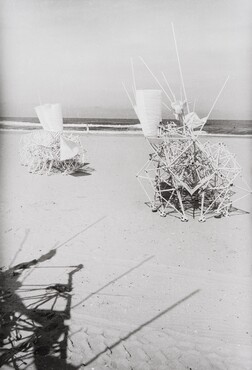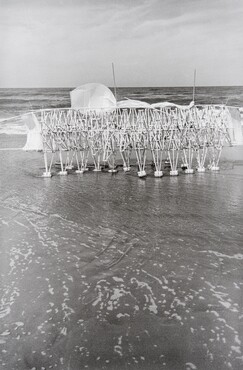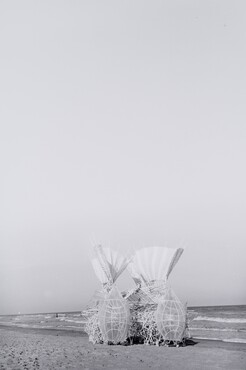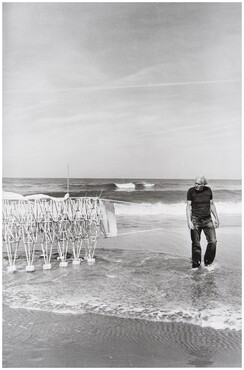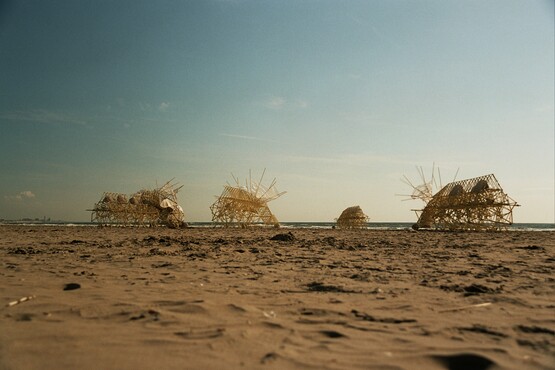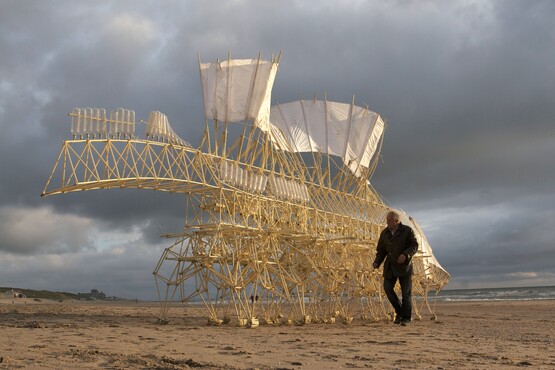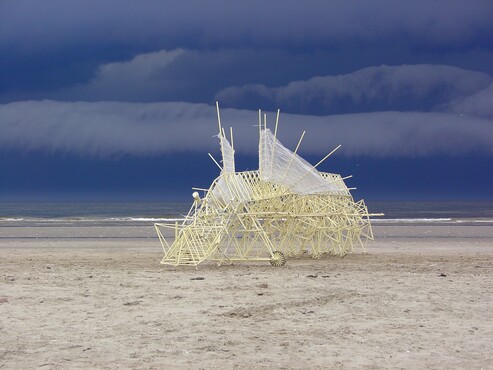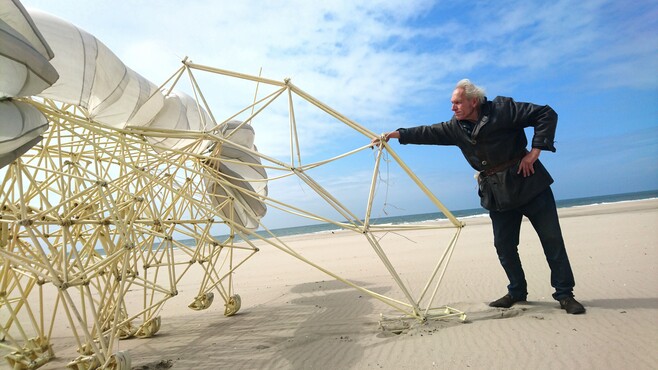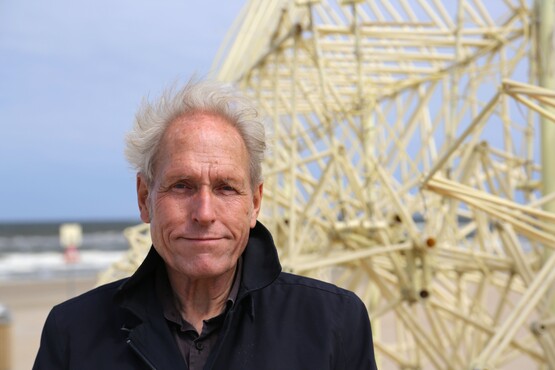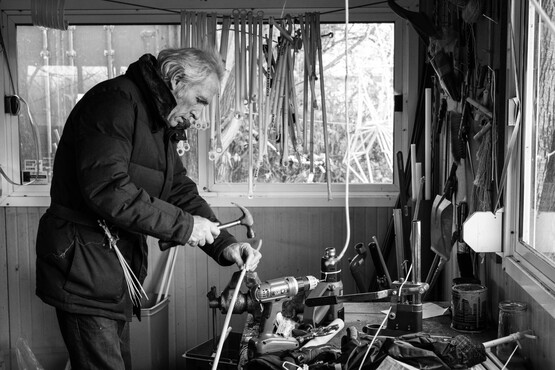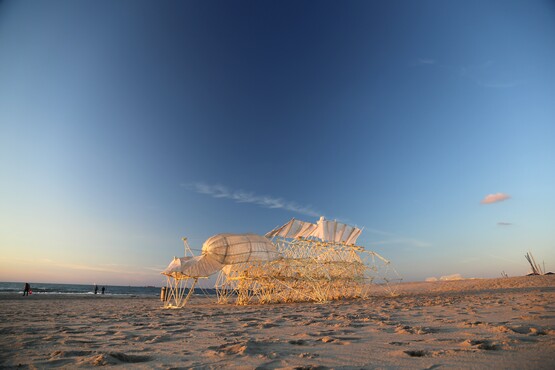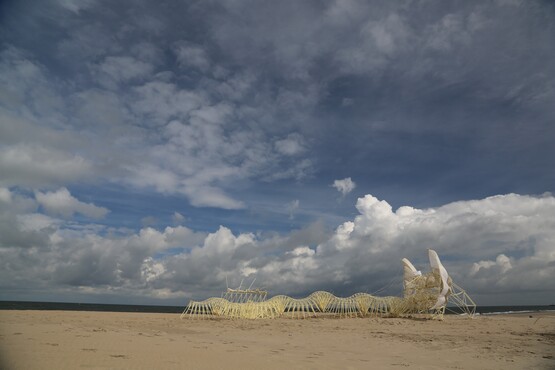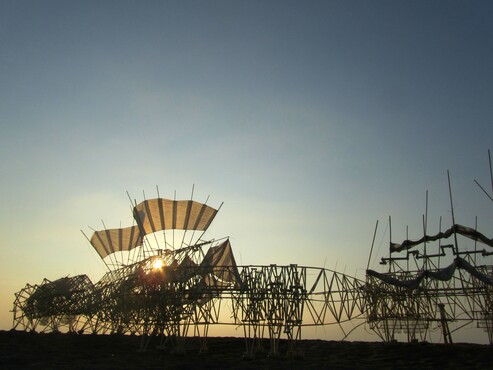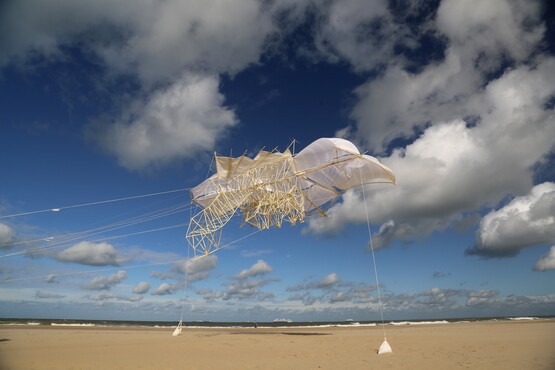Ontdek de collectie
Kunstmuseum Den Haag has a treasure chamber of over 160.000 pieces of art. Here we work on making the highlights from this collection available online.
Theo Jansen
Strandbeests: The New Generation
Impressive skeletal structures that move independently, powered by the wind: artist Theo Jansen’s (b. 1948) strandbeesten, or beach animals, can regularly be seen wandering along the Dutch coast. They have been shown all round the world, too. As well as admiring Animaris Omnia, which has hung in Kunstmuseum Den Haag’s Garden Gallery since 2018, from 26 February visitors will be able to follow the evolution of these creatures in chronological order in our Projects Gallery and beside the lake in front of the museum. ’I’ve been making new forms of life since 1990’, Jansen says. ‘The basic material is not protein, as in nature, but electrical tubing. My strandbeests get their energy from the wind, so they don’t need to eat. They have evolved over time, as can be seen in the different generations. This will be clearly visible in the presentation at Kunstmuseum Den Haag.’
What better place than his hometown, with its ties to the sea, could Jansen have chosen to show how his strandbeests have evolved? In this exhibition at Kunstmuseum Den Haag fans will have an opportunity to get to know Jansen’s work better, and a larger audience will also get the chance to discover his work. ‘Displaying ten strandbeests outside will allow us to surprise a lot of people’, says director Benno Tempel. ‘I’m sure that everyone, young and old, will be fascinated by them, and inspired to come and see the exhibition in our Projects Gallery, where they can learn more about Jansen’s vision, techniques, background and process.’
Strandbeests are more than simply art objects. Jansen tries to create actual life, with the ultimate goal of releasing his creations to live an independent life in large herds on the beach. He realises this will not be possible in the near future, but he explained his dream a few years ago in an interview with National Geographic: ‘Give me a few million years and my strandbeests will live completely independently’. Over the past few decades Jansen has continually developed the creatures, gradually making them more independent. There are now twelve generations, he says. His first creation was not mobile, and was made of PVC tubing and sticky tape, but nowadays his creatures are imposing beasts, several metres long, that move around the beach independently. They are still made of tubing, but all kinds of ingenious techniques allow them to harness the energy of the wind which they use to walk around independently, move sand and flap their wings. A ‘stomach’ made of plastic bottles can capture and release wind, allowing them to move.
Jansen first created his strandbeests with a particular purpose in mind. They were intended as a solution to a problem that is still topical today: climate change. He wrote a newspaper article about the danger of sea-level rise, and he put forward a solution: animals made of electrical tubing that would churn up the beach and blow the sand onto the dunes to reinforce them. He then followed up by actually making the creatures, and he has never stopped since. Each new species was given a Latin name – Animaris Vulgaris, Animaris Rhinoceros, Mater Extensa – and Jansen has now divided the evolution of his strandbeests into twelve periods, based on various characteristics. In the most recent period, the ‘Volantum’ (2020-2021), he has even developed a strandbeest that flies. On his website strandbeest.com there is a detailed family tree dividing all the species into the different periods.
A new publication on the latest generation of strandbeests is to be published by Hannibal Books.
Text continues below.
Theo Jansen - Opbouw Strandbeesten. Film: Studio Roodenburch
De strandbeesten zijn veel meer dan kunstobjecten. Jansen streeft ernaar om daadwerkelijk leven te maken met als ultieme doel zijn creaties zonder hulp op het strand te laten leven, in grote kuddes. Dat dit niet op korte termijn realiteit zal zijn, beseft hij zich. Maar zijn droom verwoordde hij een aantal jaar geleden duidelijk in een interview met National Geographic: ‘Geef me nog een paar miljoen jaar en mijn strandbeesten zullen volledig zelfstandig leven’. In de afgelopen decennia heeft Jansen de strandbeesten steeds verder ontwikkeld - hij onderscheidt inmiddels twaalf generaties - en daarmee vele stappen gezet richting die zelfstandigheid. Waar zijn eerste creatie nog niet mobiel was en bestond uit pvc-buizen en plakband, zie je tegenwoordig imposante, meterslange strandbeesten zelfstandig over het strand bewegen. De pvc-buizen vormen nog altijd het basismateriaal, maar door allerlei ingenieuze technieken kunnen de strandbeesten bewegen op de wind, zelfstandig lopen, zand verplaatsen en met hun vleugels wapperen. Ook kan een ‘maag’ van petflessen wind vangen en weer uitblazen en daarmee beweging mogelijk maken.
Jansen creëerde de strandbeesten niet zonder aanleiding. Hij bedacht deze als oplossing voor een nog altijd actueel probleem: klimaatverandering. Hij schreef een column over het gevaar van de stijgende zeespiegel en verzon al schrijvende een oplossing: dieren van elektriciteitsbuis die het strand loswoelen en naar de duinen blazen ter versterking. Vervolgens voegde hij de daad bij het woord en is de dieren zelf gaan maken om er vervolgens nooit meer mee op te houden. Elke nieuwe soort kreeg een Latijnse naam als Animaris Vulgaris, Animaris Rhinoceros of Mater Extensa en inmiddels heeft Jansen de evolutie van zijn strandbeesten aan de hand van de verschillende kenmerken ingedeeld in twaalf periodes. In de meest recente periode, het ‘Volantum’ (2020-2021), is zelfs een vliegende variant is ontwikkeld. Op strandbeest.com is een uitgebreide stamboom te zien waarin alle species zijn ingedeeld in de verschillende periodes.
Bij Hannibal Books verschijnt een nieuwe publicatie over de nieuwe generatie strandbeesten.
Tekst gaat door onder de foto's.
About Theo Jansen
Jansen studied physics in Delft from 1968 to 1975 before beginning his career as an artist. He painted at first and later created a UFO that caused quite a furore when it was sighted in Delft. But it was not until the 1990s, and his strandbeests, that his name became well known. From 1986 to 2008 Jansen wrote a column for the Volkskrant newspaper. A selection of his articles for the newspaper have been published in Klimmen in de lucht. In 2002 he won a career prize at the Witteveen+Bos Art+Technology Awards. In 2007 he published De Grote Fantast, in which he explains how the strandbeests came about. The photobook Strandbeest: The Dream Machines of Theo Jansen by Russian-American photographer Lena Herzog was published in 2014. Jansen has won several Dutch and international awards, including Briljanten Artist of the Year 2017, Artist of the Year (2018), the Hague Cultural Prize (2018) and the Prix Leonard Giannadda (2020). The Proboscis was shown in the Dutch pavilion at World Expo 2021 in Dubai.
Theo Jansen - Strandbeesten, de nieuwe generatie. Film: Studio Roodenburch

